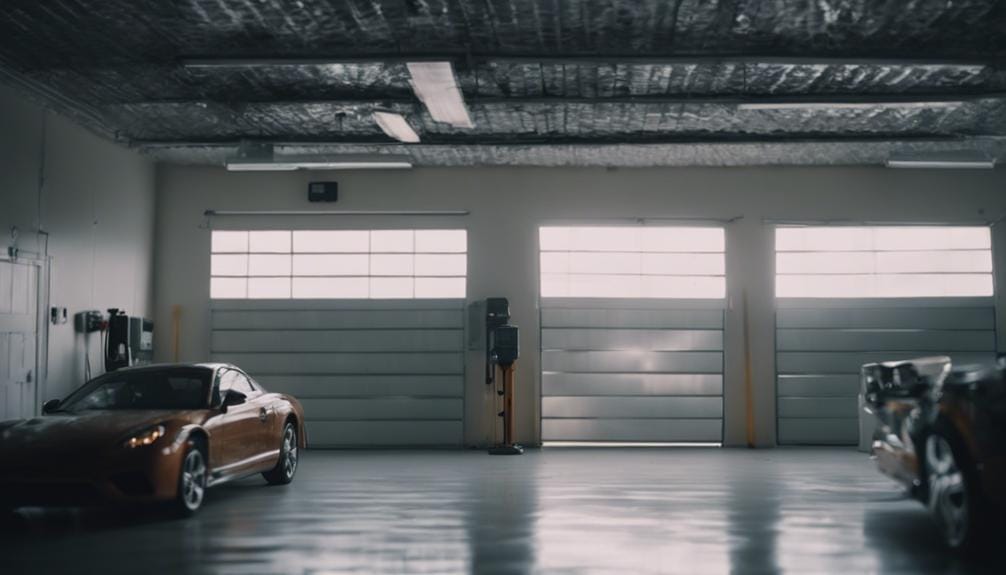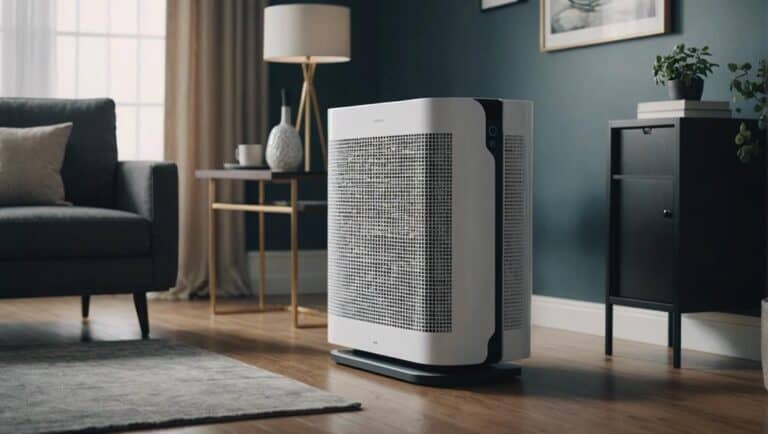10 Tips to Keep Your Garage Cool This Summer
When it comes to keeping your garage cool during the summer, it’s understandable to feel overwhelmed by the heat and unsure where to start. However, with our 10 practical tips, you can transform your hot garage into a comfortable space without breaking a sweat.
From simple ventilation strategies to smart parking considerations, you are fully supported. Stay tuned to discover how these tips can make a significant difference in maintaining a cool garage environment this summer.
Ventilation Strategies
How can we effectively implement ventilation strategies to maintain a cooler environment in the garage during the summer months? Proper ventilation in the garage plays an important role in regulating temperature and guaranteeing a comfortable workspace.
Natural ventilation methods, including windows, vents, and roof vents, allow for the circulation of fresh air, helping to reduce heat buildup. Additionally, mechanical ventilation systems, such as exhaust fans, can enhance airflow and aid in temperature control by expelling hot air from the garage.
Choosing the right ventilation system is key to achieving a cool environment in the garage. By incorporating a combination of natural and mechanical ventilation methods, ideal airflow can be achieved, leading to a more pleasant workspace, especially during the hot summer months.
Effective ventilation not only helps in maintaining a cooler temperature but also ensures proper air exchange, creating a well-ventilated environment for various activities in the garage.
Effective Fan Placement
When positioning fans in your garage, it’s important to contemplate ideal height for ceiling fans, ideally between 7-9 feet, to guarantee efficient air circulation.
Placing fans strategically near windows can aid in drawing in fresh air while expelling hot air, enhancing overall ventilation.
Wall-mounted fans offer the advantage of targeting specific areas needing extra cooling, ensuring a more tailored approach to maintaining a comfortable environment.
Fan Positioning Tips
Positioning fans effectively in your garage is important for the best air circulation and cooling during the hot summer months. When considering fan positioning, keep in mind the following tips:
- Ceiling fans: Install at a height of 7-9 feet for the most favorable air circulation.
- Garage size and layout: Tailor fan placement to suit the specific dimensions and setup of your garage.
- Wall-mounted fans: Position at least 10 inches below the ceiling to enhance airflow distribution.
- Pedestal fans: Adjust the height to direct airflow effectively, improving cooling efficiency.
- Airflow distribution: Proper positioning guarantees a comfortable temperature and enhances overall air circulation in the garage.
Air Circulation Strategies
Effective fan placement in your garage is essential for optimizing air circulation and maintaining a cool environment during the summer months. Ceiling fans, when installed at specific heights, can efficiently circulate air throughout the garage space. Strategic placement of wall-mounted or pedestal fans can offer localized cooling in areas where airflow may be lacking. Fans play a vital role in enhancing evaporation, which contributes to overall cooling effects within the garage. It is vital to take into account the dimensions of your garage when deciding where to install fans to guarantee excellent airflow. While fans may have limitations in extremely hot conditions, they still play a significant role in improving air circulation and creating a more comfortable atmosphere.
| Types of Fans | Placement | Cooling Effectiveness |
|---|---|---|
| Ceiling Fans | Specific Heights | Efficient |
| Wall-Mounted Fans | Strategic Locations | Localized Cooling |
| Pedestal Fans | Targeted Areas | Enhanced Evaporation |
Lighter Color Choices
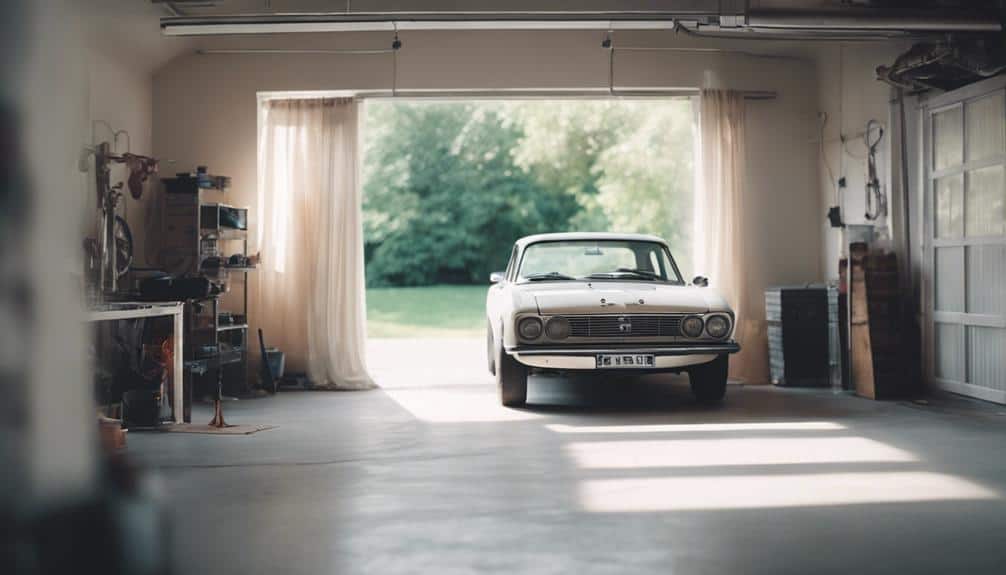
Utilizing lighter colors on garage walls aids in reflecting heat and effectively maintaining a cooler temperature indoors. Lighter colors, such as white, play an important role in combating heat buildup during the summer months. Here are five key reasons why lighter color choices are beneficial for cooling your garage:
- Reduced Heat Absorption: Lighter colors have lower heat absorption rates, helping to prevent the walls from becoming too hot.
- Effective Temperature Control: Lighter colors are more efficient at maintaining a comfortable temperature inside the garage.
- Noticeable Cooling Effect: White walls, in particular, can make a significant difference in cooling the garage environment.
- Simple Solution: Opting for lighter colors is a straightforward and effective way to combat heat buildup without complex installations.
- Reflective Properties: Lighter colors reflect heat away from the walls, contributing to a cooler overall garage temperature.
Insulation Techniques
To effectively insulate your garage and keep it cool during the summer months, sealing garage doors, installing weather stripping, and adding insulation panels are essential steps.
These actions will help minimize heat transfer and maintain a comfortable temperature inside the garage.
Seal Garage Doors
Insulating garage doors greatly reduces heat transfer, maintaining a consistent temperature inside and saving on energy costs. When it comes sealing garage doors effectively, there are several key methods to take into account:
- Weatherstripping: Installing weatherstripping around the edges of the garage door helps seal any gaps or cracks, preventing hot air from entering and cool air from escaping.
- Foam board: Adding foam board insulation to the interior of the garage door can provide additional thermal resistance, improving overall energy efficiency.
- Reflective barriers: Reflective barriers, such as radiant barriers or reflective foil insulation, can help reflect heat away from the garage, keeping it cooler during hot summer days.
- Sealing gaps and cracks: Properly sealing any gaps or cracks in the garage door itself is essential to prevent heat transfer and maintain a consistent temperature.
- Energy cost savings: By effectively insulating and sealing garage doors, homeowners can significantly reduce energy costs over time.
Install Weather Stripping
Weather stripping serves as an important element in maintaining garage temperature control by sealing gaps and preventing heat transfer. Installing weather stripping around garage doors is critical for enhancing energy efficiency and improving insulation. Different materials like vinyl, rubber, and foam can be used based on specific needs.
Vinyl weather stripping is durable and provides a tight seal, while rubber is effective for irregular surfaces. Foam weather stripping is cost-effective and easy to install. Properly sealed gaps with weather stripping not only help in temperature control but also contribute to lower energy bills.
Regular upkeep of weather stripping is vital to guarantee its longevity and effectiveness in keeping the garage cool.
Add Insulation Panels
Adding insulation panels to your garage walls greatly enhances temperature control and comfort, particularly in hot summer conditions. Insulation panels like foam board or fiberglass batts effectively reduce heat transfer, helping to maintain a cooler temperature inside your garage during the hot summer months. Here are some key points to bear in mind:
- Insulation panels are easy to install, making it a convenient solution for regulating temperature.
- Foam board insulation provides high R-values, offering better thermal resistance and energy efficiency.
- Properly insulated walls act as a barrier against outdoor heat, improving overall comfort in your garage.
- Insulation panels are a cost-effective way to enhance temperature regulation and energy savings.
- By adding insulation panels, you can enjoy a more comfortable garage environment year-round.
Dehumidifier Usage
Utilizing a dehumidifier in your garage effectively reduces moisture levels, safeguarding against mold and mildew while maintaining a more comfortable environment. Dehumidifiers are essential tools for controlling garage humidity, especially in humid climates where moisture buildup is a common issue. By extracting excess moisture from the air, these devices not only prevent mold growth but also help protect tools, equipment, and stored items from humidity damage. Additionally, dehumidifiers contribute to overall garage comfort and air quality by keeping humidity levels in check.
| Benefits of Dehumidifier Usage | |
|---|---|
| 1. Reduces moisture levels | 4. Protects tools |
| 2. Prevents mold growth | 5. Ideal for humid climates |
| 3. Enhances air quality | 6. Maintains comfortable environment |
Decluttering for Coolness
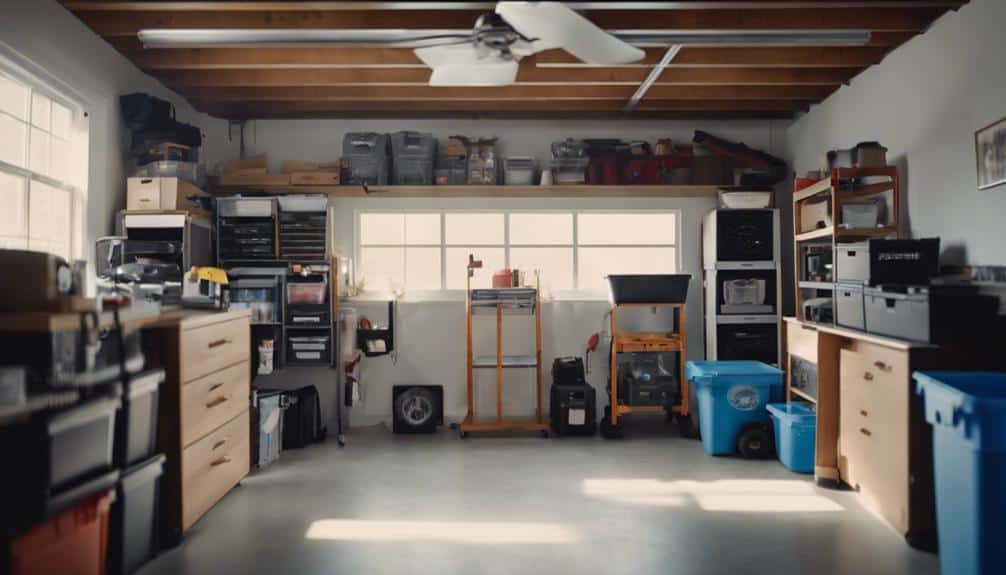
To achieve a cooler garage environment, decluttering is imperative as it allows for better airflow and prevents heat buildup caused by obstructed spaces. Clutter in the garage blocks airflow and raises temperatures, creating a stagnant and hotter environment. Stacked boxes and tools on the floor hinder airflow, leading to increased heat retention. Decluttering the garage improves organization, airflow, and parking convenience for a cooler space.
Utilizing shelves, cabinets, or storage racks helps maintain a clutter-free environment with better temperature control. Regular tidying up of the garage aids in keeping temperatures in check by promoting airflow.
- Utilize shelves and storage racks: Store items off the floor to maximize airflow.
- Organize tools and equipment: Arrange them neatly to prevent blockages.
- Clear out unnecessary items: Create a clutter-free space for improved airflow.
- Regularly tidy up: Maintain a clean environment to aid temperature control.
- Enhance parking convenience: Keep the garage organized for easier access and a cooler space.
Utilizing Air Conditioning
When considering AC placement in your garage, it’s crucial to place the unit where it can efficiently cool the space. Ideal positioning can help distribute cool air evenly and prevent hot spots.
Energy-efficient cooling solutions like mini-split or through-the-wall air conditioners can effectively cool windowless garages while reducing energy expenses.
AC Placement Tips
Proper placement of your air conditioner within the garage is important for ensuring efficient cooling and ideal airflow distribution. When considering the placement of your AC unit, keep the following tips in mind:
- Place the AC near the center of the garage: This helps in distributing cool air evenly.
- Avoid obstacles: Ensure the air conditioner isn’t placed near corners or obstacles that obstruct airflow.
- Best height: Position the AC unit at a height that allows for better air circulation throughout the garage.
- Consider professional installation: Professional installation can maximize the cooling effectiveness of your air conditioner.
Energy Efficient Cooling
Positioning the air conditioning unit at a prime location within the garage is key to maximizing energy efficiency and maintaining a consistently cool environment. Energy-efficient air conditioning units can reduce cooling costs by up to 50% compared to conventional models. Properly sized air conditioners guarantee top performance and energy efficiency in cooling the garage. Regular maintenance of air conditioning systems improves efficiency and prolongs the unit’s lifespan. Programmable thermostats help regulate temperature, reducing energy consumption by adjusting settings based on usage patterns. By implementing energy-efficient cooling practices, a more sustainable and cost-effective garage cooling solution can be achieved.
| Energy Efficient Cooling Tips | |||
|---|---|---|---|
| 1. Use energy-efficient units | 2. Size matters | 3. Regular maintenance is crucial | 4. Opt for programmable thermostats |
Parking Considerations

Considering where you park your vehicle plays an important role in maintaining a cool temperature in your garage during the summer months. Parking a hot vehicle inside the garage can greatly raise the temperature, as heat radiates from the parked car, contributing to increased garage heat. To prevent unnecessary heat buildup, it’s advisable to park outside initially. Additionally, parking recently used vehicles outside before bringing them into the garage can help in managing the garage temperature. Remember that parking a hot car inside can escalate the garage temperature by several degrees, impacting the overall comfort of the space.
- Park outside initially to prevent unnecessary heat buildup.
- Consider parking recently used vehicles outside before bringing them into the garage.
- Parking a hot car inside can greatly raise the garage temperature.
- Heat radiates from a parked car, contributing to increased garage heat.
- Elevate the garage temperature by several degrees by parking a hot vehicle inside.
Shade and Awning Installation
Installing shades or awnings outside the garage can effectively reduce direct sunlight and heat infiltration, enhancing the overall cooling efficiency of the space. A properly placed shade structure has the potential to block up to 90% of solar radiation, greatly lowering the temperature inside the garage. Awnings strategically positioned over windows or doors act as barriers, preventing heat buildup and improving the garage’s cooling performance. Opt for light-colored or reflective materials when selecting awnings to minimize heat absorption and maximize the cooling benefits. By thoughtfully choosing the placement of shades and awnings, a more comfortable environment can be created within the garage during the sweltering summer months.
| Benefits of Shade and Awning Installation |
|---|
| Reduces direct sunlight |
| Blocks up to 90% of solar radiation |
| Prevents heat buildup |
| Improves cooling efficiency |
| Creates a more comfortable environment |
Natural Cooling Methods
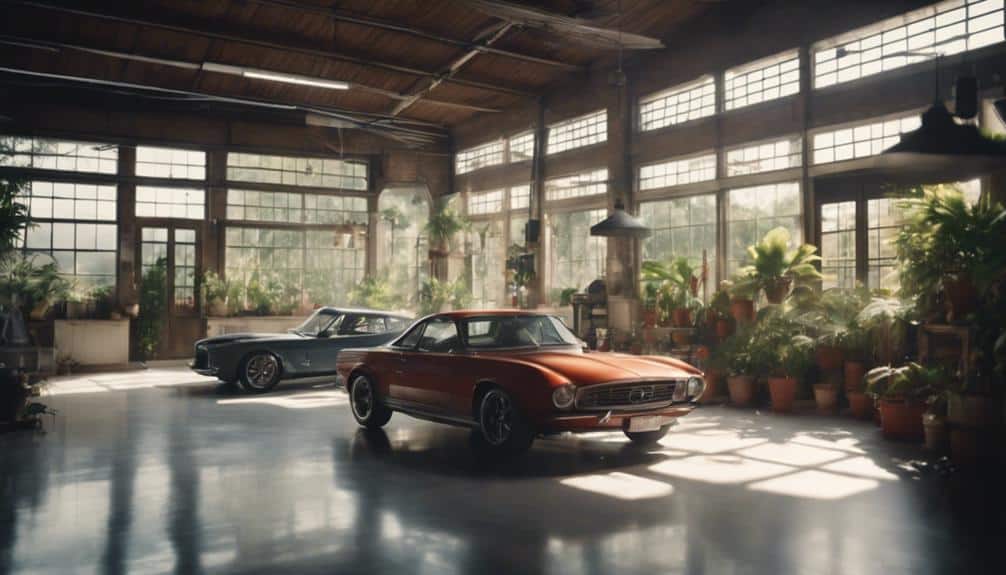
To enhance the natural cooling efficiency of a garage during the summer months, consider utilizing various methods such as:
- Utilize natural ventilation by opening windows and doors to allow fresh air circulation in the garage.
- Install roof vents to facilitate heat dissipation and improve airflow within the garage space.
- Position fans strategically to create cross-ventilation and enhance cooling effects without energy consumption.
- Plant shade trees near the garage to reduce direct sunlight exposure and lower the overall temperature.
- Use reflective window coatings to deflect sunlight and prevent heat buildup inside the garage during summer months.
Conclusion
To sum up, implementing a combination of ventilation strategies, insulation techniques, and parking considerations can effectively keep your garage cool during the summer months.
Utilizing fans, lighter colors, and shade installations can help regulate temperature, while improving insulation and parking outside can further enhance comfort.
By following these tips, you can create a more comfortable and enjoyable environment in your garage throughout the hot summer season.
